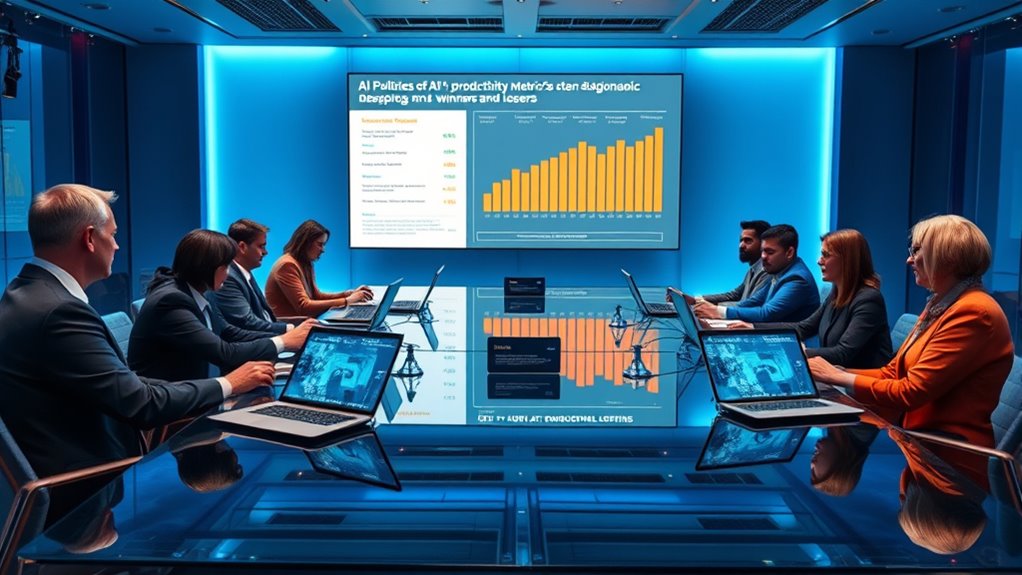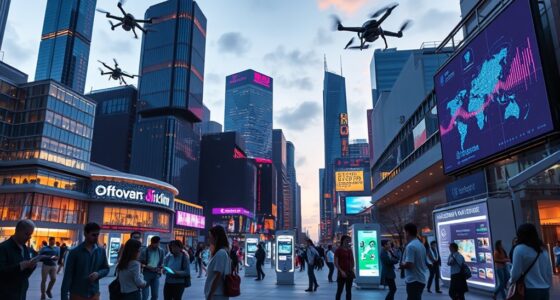AI’s productivity boom is delivering huge economic gains, but the benefits aren’t spread evenly. Wealthier regions and high-income workers are reaping much of the rewards, while developing areas and lower-income groups risk falling behind due to infrastructure gaps and job disruptions. Understanding who truly benefits requires examining how these gains are distributed across industries and communities. To see how policies and innovations can shape a more inclusive future, keep exploring further insights.
Key Takeaways
- Wealthier regions and high-income workers benefit most from AI-driven productivity gains due to better infrastructure and resources.
- A small elite of companies in the US and China captures a significant share of AI R&D benefits, widening economic disparities.
- AI boosts profits and efficiency mainly for large, established firms, leaving smaller or less technologically advanced businesses behind.
- Displaced workers and lower-skilled employees face job risks, with benefits skewed toward sectors and roles that adopt AI earliest.
- Regional disparities grow as metropolitan areas leverage AI faster, potentially marginalizing developing countries without infrastructure upgrades.
The Global Economic Impact of AI-Driven Gains

AI is revolutionizing the global economy by adding trillions of dollars in value and boosting productivity across industries. By 2030, AI could contribute $15.7 trillion, increasing local GDPs by nearly 26%. McKinsey estimates annual global economic gains between $17.1 trillion and $25.6 trillion, transforming how industries operate. The AI market itself is expected to grow from $208 billion in 2023 to $1.8 trillion by 2030, a compound annual growth rate of 36.6%. Productivity in sectors exposed to AI has nearly quadrupled, rising from 7% to 27% between 2018 and 2024. This surge benefits companies with a 45% profit increase and a 22% reduction in process costs, illustrating AI’s powerful role in driving economic growth worldwide. AI’s rapid adoption continues to accelerate, fueling innovation and competitiveness across the global landscape. Additionally, the productivity gains driven by AI are reshaping workforce dynamics and industry standards on a global scale.
Disparities Across Regions and Income Groups

You can see that AI’s benefits are unevenly distributed across regions and income groups, often widening existing gaps. Wealthier areas and higher-income workers tend to gain more, leaving rural communities and lower-income workers behind. This growing divide risks deepening economic inequalities, especially as infrastructure and access to AI tools remain unequal. Over half of OECD regions have employment rates above 70%, yet regions facing population decline and aging populations also experience labour gaps, which AI could either help alleviate or exacerbate depending on policy choices. Additionally, disparities in digital infrastructure can hinder equitable AI adoption across different communities.
Wealth Gap Widening
The growing concentration of AI-driven productivity gains is widening the wealth gap both within and across regions. Just 100 companies in the US and China are responsible for about 40% of global AI R&D investment, funneling most benefits to shareholders and executives. Meanwhile, workers see wages stagnate or lag behind productivity growth, deepening income disparities. The Global South remains largely excluded from AI governance, missing out on economic gains and increasing regional inequality. Advanced economies in North America, Europe, and East Asia lead AI adoption, boosting their wealth, while many countries and rural areas fall behind, losing opportunities. Workers with specialized AI skills earn premiums, but those without access face displacement and stagnant wages. AI’s benefits are increasingly concentrated among a small elite, which amplifies the global and local wealth gap.
Infrastructure Inequities
Why do some communities reap the benefits of AI-driven productivity while others lag behind? It all comes down to digital infrastructure gaps. Regions with limited broadband access and data hosting capacity can’t fully adopt AI, stunting growth. Developing nations and rural areas often lack the high-speed internet crucial for AI, leaving them behind. Metropolitan areas with strong infrastructure accelerate AI integration, widening the divide. Digital infrastructure gaps hinder AI adoption in underprivileged areas. Moreover, the uneven distribution of digital infrastructure often correlates with existing socioeconomic inequalities, further entrenching disparities. Infrastructure investments can create middle-wage jobs. Developing countries risk economic marginalization without upgrades. Addressing digital disparities is essential to prevent increased regional and income inequalities. Bridging these gaps requires targeted policies and investments to ensure everyone benefits from AI’s productivity gains.
How AI Is Reshaping Job Tasks and Employment

AI is transforming how you work by automating routine tasks and shifting roles toward higher-level skills. As jobs evolve, you’ll likely collaborate more with AI systems rather than compete against them. This shift impacts employment opportunities, skill requirements, and wage structures across industries. For example, Pimple Patch technology demonstrates how targeted, innovative solutions can address specific problems efficiently, paralleling how AI tailors tasks to individual needs and streamlines processes.
Job Automation Risks
As automation advances, job tasks across various industries are transforming rapidly, posing significant risks to employment stability. You should be aware that up to 300 million jobs worldwide could be lost to AI in the coming years. Nearly half of US workers face potential displacement within the next decade, and 14% of the global workforce may need to change careers by 2030. AI is already causing workforce reductions, with nearly 78,000 jobs lost in 2025 alone. Automation has resulted in 1.7 million manufacturing jobs lost since 2000, highlighting the ongoing impact of AI-driven automation on employment. Additionally, the rapid pace of technological change makes ongoing job market adaptation essential for workers to stay relevant in evolving industries.
You’ll also see:
- 60% of jobs in advanced economies at risk of automation
- Entry-level and retail roles highly susceptible, up to 65% potentially automated
- Tech and manufacturing sectors experiencing significant layoffs
- Routine tasks evolving into AI-driven responsibilities
- Immediate reductions, with 41% of employers planning workforce cuts within five years
Workforce Skill Shifts
Have you noticed how job tasks are shifting rapidly due to technological advancements? AI is automating routine and specialized functions, forcing you to develop new skills to stay relevant. Traditional skills are less in demand, while AI literacy and the ability to work alongside AI tools are increasingly essential. Many roles now require hybrid expertise, blending technical knowledge with domain-specific insights. As AI integrates into workflows, you’ll need to adapt by honing problem-solving, data analysis, and collaboration skills. This shift is transforming job profiles, emphasizing continuous learning and flexibility. Companies are expecting workers to manage AI systems, oversee algorithms, and interpret AI-generated insights. If you want to thrive, investing in AI-related training and staying adaptable becomes vital in this evolving labor landscape. Additionally, education institutions are increasingly offering upskilling programs and industry partnerships to support this transition. Recognizing the importance of technological proficiency, many organizations are incorporating AI training into their employee development initiatives.
Estimating AI’s Contribution to Productivity Growth

Estimating AI’s true contribution to productivity growth involves analyzing diverse data sources and measuring changes across industries. You see, industries exposed to AI have nearly quadrupled their productivity growth since 2022, jumping from 7% to 27%. Meanwhile, less-exposed sectors barely grew, from 10% to 9%. Revenue per employee in AI-driven sectors is now three times higher, and Goldman Sachs estimates AI could boost annual productivity by 0.3 to 3 percentage points. Consider these points: Impact of AI on productivity and revenue growth AI adoption contributes to a projected 7% increase in global GDP. AI-driven sectors like finance and software see the highest gains. Companies report 22% operational cost savings. Workers experience up to 80% productivity boosts. Content clusters facilitate the development of comprehensive and interconnected resources, amplifying AI’s positive effects across industries. AI adoption is widespread, with 72% of organizations integrating tools by 2024. These data highlight AI’s significant, measurable impact on productivity.
Trust, Governance, and the Realization of AI Benefits

Trust and governance are crucial for turning AI’s potential into tangible benefits. When organizations invest over $1 million annually in responsible AI practices, they boost trust, reduce errors, and improve brand reputation—leading to cost savings and efficiency gains. Larger firms with high RAI maturity report key benefits, including a 34% rise in consumer trust. Public trust varies by region and demographic, with transparency and accountability critical for acceptance, especially in high-risk areas like healthcare and employment. Governments and organizations focus on strengthening trust through third-party evaluations and ethical frameworks. Including public voices ensures AI aligns with societal values, fostering fairness and transparency. Research shows that higher levels of RAI maturity are associated with increased organizational resilience and stakeholder confidence. Additionally, implementing ethical frameworks can help organizations navigate complex societal expectations and mitigate risks related to misuse or bias. Ultimately, robust governance and trust are essential for translating AI’s productivity potential into equitable, widespread benefits that society can rely on.
Challenges in Achieving Equitable AI-Driven Growth

Achieving equitable AI-driven growth faces significant hurdles due to uneven adoption and productivity gains across industries. Some sectors, like finance and software publishing, see productivity jumps of nearly four times, while others such as mining and hospitality experience stagnation or declines. Revenue per employee in AI-heavy industries is about three times higher than in less exposed ones, risking increased sectoral inequality. Investment focuses heavily on advanced fields, leaving traditional industries behind and limiting broad economic benefits. The rapid development of AI tools and infrastructure further amplifies these disparities, as resource-rich organizations are better positioned to leverage AI advantages. This technological gap threatens to deepen economic divides unless addressed through targeted policies and inclusive strategies. Additionally, the varying pace of AI integration across sectors underscores the need for tailored support to bridge these productivity gaps and promote equitable growth.
The Short- and Long-Term Inflation Effects of AI

AI can initially reduce inflation by boosting supply and productivity, but expectations about future gains might cause short-term price spikes. Over time, AI-driven demand could push inflation higher, though sustained growth may also lead to lower inflation trends. Understanding these contrasting effects helps you see how AI influences both immediate prices and long-term inflation paths. Sound healing science reveals how specific frequencies can influence brainwave patterns, illustrating the nuanced ways AI may impact economic and health outcomes in the future.
Short-Term Price Pressures
In the short term, increased investment and demand driven by AI adoption can lead to temporary inflation spikes. As businesses pour money into AI tools, infrastructure, and upskilling, prices for goods and services climb before efficiency gains kick in. You’ll notice demand-pull inflation as consumption rises, especially in sectors heavily investing in AI. The inflationary pressure peaks early when operational costs increase due to capital spending. However, these pressures are likely to stabilize once productivity boosts reduce costs over time.
- Higher investment levels boost demand and prices initially
- Businesses spend on AI tools, driving up costs
- Demand-pull inflation affects goods and services
- Inflation peaks during early AI adoption phases
- Prices tend to moderate as productivity gains materialize
Long-Term Deflation Trends
As investment and demand driven by AI adoption increase, their long-term effects are likely to push overall price levels downward. AI-driven productivity growth creates sustained deflationary pressures across economies, lowering prices in multiple industries rather than just shifting pricing models. By expanding aggregate supply, AI boosts output, savings, and investment, which collectively reduce prices over time. As AI enhances labor productivity and increases capital per worker, economies may experience disinflation or outright deflation unless demand keeps pace. With supply-side effects like lower operational costs, improved supply chain efficiency, and structural cost reductions, prices tend to fall as supply grows faster than demand. The pace of AI diffusion influences the magnitude of deflation, especially in sectors more exposed to automation and technological innovation. Historical data indicates that technological revolutions have historically led to significant declines in prices, reinforcing the potential for AI to generate similar long-term deflationary trends.
Climate Risks and Their Potential to Offset AI Gains

Climate risks pose a significant threat to the potential gains from AI-driven productivity. Rising temperatures and extreme weather can undo advancements by damaging infrastructure, increasing costs, and reducing labor efficiency. You face risks like:
- GDP reductions of over 21% by 2100 if climate impacts worsen.
- Disrupted supply chains and infrastructure damage hamper AI deployment.
- Increased healthcare costs from climate-related health issues.
- Natural disasters causing billions in damages, disrupting industries.
- Widening inequality as vulnerable populations bear the brunt of climate shocks.
These challenges threaten to offset or even erase the economic benefits of AI productivity. Without effective mitigation, climate change could undermine decades of technological progress, making it vital to address environmental risks alongside AI investments.
The Role of Policy in Shaping AI’s Economic Outcomes

Policy plays a crucial role in shaping the economic outcomes of AI by setting the rules and incentives that guide its adoption and development. You need regulatory frameworks that promote transparency, building trust and accountability essential for widespread integration. Modernizing intellectual property laws encourages innovation while safeguarding creators. Governments investing in AI education and reskilling can help workers adapt and benefit from productivity gains. Incentives like tax credits or grants motivate companies to adopt AI faster, boosting economic growth. Addressing labor market shifts requires targeted policies to support vulnerable sectors, promote inclusive growth, and ensure fair wages for AI-related skills. Evolving labor regulations and social safety nets help manage displacement. AI’s predicted macroeconomic effects are likely to be less revolutionary than some predictions suggest, and effective policies ensure AI’s economic benefits are broad, equitable, and sustainable.

The rapid adoption of AI presents both tremendous opportunities and significant risks that organizations must navigate carefully. You can access massive growth potential, improve productivity, and stay competitive. However, challenges like data accuracy, integration, and ethical concerns loom large. To succeed, consider these key points:
- Embrace AI’s ability to boost local GDP by up to 26% by 2030.
- Prepare for infrastructure, talent, and ethical hurdles as adoption accelerates.
- Focus on sectors like healthcare, logistics, and cybersecurity for disruptive gains.
- Address the risk of widening gaps between industry leaders and laggards.
- Invest in change management to guarantee smooth integration and maximize benefits.
- Recognize that AI-driven productivity could transform labor markets and industry structures over the coming decades.
Frequently Asked Questions
How Will AI Impact Income Inequality Worldwide?
You might be surprised to learn that nearly a third of the world’s population lacks internet access, missing AI benefits. AI could widen income gaps globally, as advanced countries reap more productivity gains, leaving low-income nations behind. Within countries, wealth concentrates among capital owners, and high-wage workers might see earnings grow, while low-skilled jobs decline. Without policies ensuring digital inclusion, AI risks deepening existing inequalities both across and within nations.
What Policies Can Ensure Equitable AI Benefits Globally?
You can guarantee equitable AI benefits globally by supporting policies that promote international cooperation, like establishing governance bodies and sharing data ethically. Invest in digital infrastructure and affordable internet to bridge divides. Implement inclusive labor policies, such as reskilling programs and social safety nets, to protect workers. Encourage transparent, responsible AI development and foster local innovation, ensuring AI advancements serve diverse communities and reduce inequalities worldwide.
Will AI Cause Long-Term Job Displacement or Create New Roles?
You might worry that AI will cause long-term job displacement, like how manufacturing jobs declined after automation. However, history shows new roles emerge, such as AI system trainers or data analysts. While some jobs are lost, you’ll find opportunities in managing and developing AI tools. Your skills can evolve, leading to new careers. Embracing lifelong learning helps you stay ahead despite AI’s disruptive impact.
How Does AI Governance Influence Economic Growth Outcomes?
You see, AI governance shapes economic growth by setting rules that encourage widespread adoption and fair benefits. When policies promote infrastructure and workforce skills, regions can gain access to productivity gains. Effective governance also fosters international cooperation, reducing inequalities. By balancing innovation with regulation, you guarantee AI-driven growth benefits more people, prevents concentration of wealth, and supports sustainable development—ultimately creating a more inclusive and resilient economy.
Can Low-Income Countries Fully Leverage AI for Development?
Imagine trying to sail a boat without enough wind—that’s how low-income countries feel about leveraging AI for development. While AI offers growth potential, these nations face hurdles like limited infrastructure and data access. Without investment in digital skills, ecosystems, and policies, they risk being left behind in the AI race. To fully benefit, they must harness local talent and build partnerships, turning challenges into opportunities for sustainable progress.
Conclusion
As you ponder AI’s true beneficiaries, remember: the future isn’t written in code but in the choices we make today. Will we harness AI’s potential to lift all voices or let disparities deepen? Like a double-edged sword, its power can cut both ways. The question isn’t just who profits now, but who’s left behind tomorrow. You hold the pen—what story will you help write in AI’s unfolding chapter?









